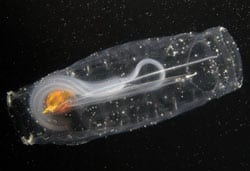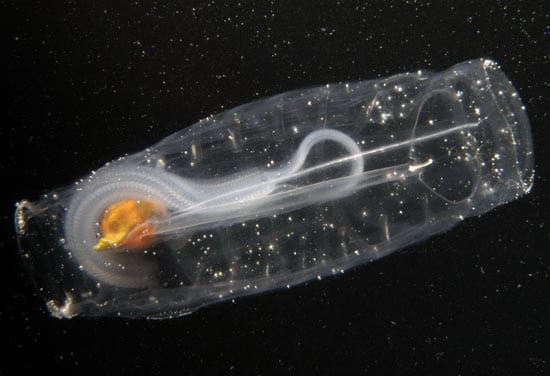
Transparent Salps May Play Conspicuous Ecological Role
WHOI biologist Larry Madin led an expedition to waters off Antartica to learn about little-known gelatinous animals.
WHOI biologist Larry Madin sped through space and time in December 2004—going from late fall in New England at WHOI to early summer in the Southern Ocean aboard the R/V Laurence M. Gould. Madin led a National Science Foundation-sponsored research expedition across the Drake Passage and the Antarctic Circle. He and colleagues towed nets behind the vessel and scuba dove day and night in -1°C (30°F) water (though “night” in December in the Antarctic is only a brief dusk).
Their quest was salps—transparent, gelatinous animals whose large populations contain both 10-centimeter-long specimens (right) and colonies that form chains several meters long. The researchers sought to learn the rudiments of this little-known southern hemispheric species: how much they eat, how fast they reproduce, and how much organic matter they transport to deeper water.
Salps can quickly generate massive populations that consume microscopic marine plants called diatoms. In some years, salp swarms may replace krill, which also eat diatoms. But while krill provide a rich, critical food source for whales and penguins, salps provide little nutrition.
Scientists speculate that global warming may favor salps over krill because diminishing sea ice provides less shelter and food for young krill. Madin’s group will revisit the area next February to continue to learn more about salps’ role in the fertile Southern Ocean ecosystem.
Image

Slideshow
 MARINE 'VACUUM CLEANERS'—Each solitary, fragile, glassy 10-centimeter individual of Salpa thompsoni can produce hundreds of identical offspring when their food is abundant. Salps are planktonic filter-feeders, each one a tireless vacuum continuously clearing phytoplankton cells from the sea by filtering water through a mucus net as it swims. They can occur as individuals (above) or in colonies that form long, connected chains. Bubbles formed in and on this salp when it was caught in cold Southern Ocean water and brought into a lab, where its surrounding water warmed. (Photo by Laurence Madin, WHOI)
MARINE 'VACUUM CLEANERS'—Each solitary, fragile, glassy 10-centimeter individual of Salpa thompsoni can produce hundreds of identical offspring when their food is abundant. Salps are planktonic filter-feeders, each one a tireless vacuum continuously clearing phytoplankton cells from the sea by filtering water through a mucus net as it swims. They can occur as individuals (above) or in colonies that form long, connected chains. Bubbles formed in and on this salp when it was caught in cold Southern Ocean water and brought into a lab, where its surrounding water warmed. (Photo by Laurence Madin, WHOI)
